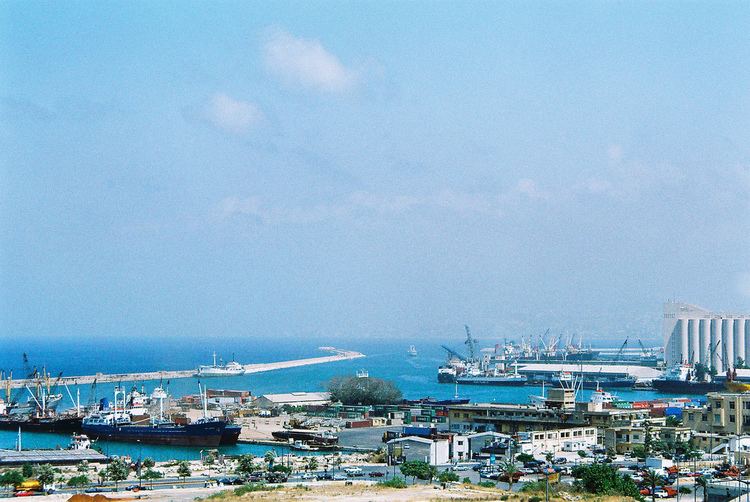Size of harbor 1.002 km Phone +961 1 580 211 Opened 1887 | Type of harbor Artificial Address Beirut, Lebanon Owner Politics of Lebanon | |
 | ||
Operated by Gestion et exploitation du port de Beyrouth (GEPB) | ||
The Port of Beirut (Arabic: مرفأ بيروت) is the main port in Lebanon located on the eastern part of the Saint George Bay on Beirut's northern Mediterranean coast, west of the Beirut River. It is one of the largest and busiest ports on the Eastern Mediterranean. The Port of Beirut and Beirut Rafic Hariri International Airport are the main ports of entry into the country.
Contents
- Port of beirut accident 10 2 2014
- Beirut Container Terminal Consortium
- Phase I
- Phase II
- Pollution from ships
- References
The port is operated and managed by the Gestion et exploitation du port de Beyrouth (GEPB), which is French for Port Authority of Beirut. Container terminal operations are subcontracted to a private consortium called the Beirut Container Terminal Consortium (BCTC).
Since the end of the Lebanese Civil War in 1990, the port has gone through a major updating and expansion program with the rehabilitation of existing port facilities, the construction of new administration buildings, and the construction of a new container terminal.
It's an important gateway for transporting freight to Syria, Jordan, Iraq, and the Gulf States.
The Port of Beirut has a total area of 1,200,000m2 and has 4 basins, 16 quays, and a new container terminal at quay 16 capable of handling 745,000 twenty-foot equivalent units (TEU) per year.
The Free Zone includes three industrial buildings with warehouses covering a total area of 32,400m2 and a commercial building with 46 duty-free shops covering an area of 11,200m2. In 2007, the Logistic Free Zone (LFZ) was established containing several logistics warehouses where goods can undergo transformations before being exported via land, sea, and air or imported into Lebanon.
The general cargo area consists of 12 warehouses and a grain silo with a capacity of 120,000 tons of grain.
The Port of Beirut has been selected as a transshipment hub for the second and third largest container shipping companies in the world, Swiss-based Mediterranean Shipping Company (MSC) and French-based Compagnie Maritime d’Affrètement - Compagnie Générale Maritime (CMA-CGM). The latter building a $12 million regional headquarters building near the port.
The passenger terminal is located along quay 5 facing the second basin of the port. The facility was deemed outdated and inadequate, so it is being reconstructed into a modern 600m2 facility that will have a decorative front sail structure. It is scheduled for completion early this year.
The historic first basin of the port, which hosts the Beirut Naval Base, will be completely redeveloped by Solidere, the $2 billion Lebanese real estate company that is rebuilding the Beirut Central District (BCD). The redevelopment will involve transforming quays 1 and 2 into a public promenade along with the construction of leisure commercial properties.
The port lacks a railway connection, however, as part of long term plans to reinstate the railway system in Lebanon, plans are to have a railway link to the port.
Port of beirut accident 10 2 2014
Beirut Container Terminal Consortium
Management and operation of the container terminal is subcontracted to the Beirut Container Terminal Consortium (BCTC) which is made up of the Lebanese-based International Port Management Beirut (IPMB), British-based Portia Management Services (PMS), and American-based Logistics and Port Management, Americas (LPMA). It was established in December 2004 and began operations in 2005, although the container terminal facilities were completed in 2000.
The majority of container traffic is handled by the new quay 16, the longest and deepest of all the quays at a length of 600m and a draft of 15.5m allowing it to accommodate the largest container ships in the world. It has a stacking area of 365,000m2 allowing it to process up to 745,000 TEU per year.
Quay 16 is equipped with 6 Super-post-Panamax container cranes and 18 rubber tyred gantry cranes manufactured by Shanghai Zhenhua Heavy Industry Company (ZPMC).
Due to the very high traffic the container terminal is experiencing, the BCTC reached an agreement with the port authority to utilize the older quays 12, 13, and 14 for handling smaller container ships when quay 16 is occupied. This allows the container terminal to process up to 1,200,000 TEU per year and reduce vessel wait times. Container ships that are processed at these older quays as well as quay 15 have their containers loaded and unloaded by two mobile harbour cranes manufactured by Gottwald Port Technology.
Phase I
The first phase of the container terminal expansion was launched last year and involves expanding quay 16 by 500m to the east reaching the mouth of the Beirut River by reclaiming 140,000m2 of land creating a new 180,000m2 stacking area for containers. This will extend the quay from its present 600m to 1,100m. The draft along the expanded quay will be 17.5m. The existing detached breakwater for quay 16 will also be extended. The expansion will increase the container terminal capacity by 450,000 TEU allowing the terminal to process 1,500,000 TEU per year. The Danish-Lebanese joint venture, Pihl-Hourie, won the contract for the expansion project which will cost $128 million and be completed in 2012.
Phase II
Once the first phase is completed in 2012, the second phase will be launched which will involve filling in the 4th basin of the port, bridging quays 12 and 16, creating a continuous 2,300m long quay increasing the container terminal capacity by 600,000 TEU allowing the terminal to process 2,100,000 TEU per year.
Pollution from ships
See Marine environmental issues in Lebanon
